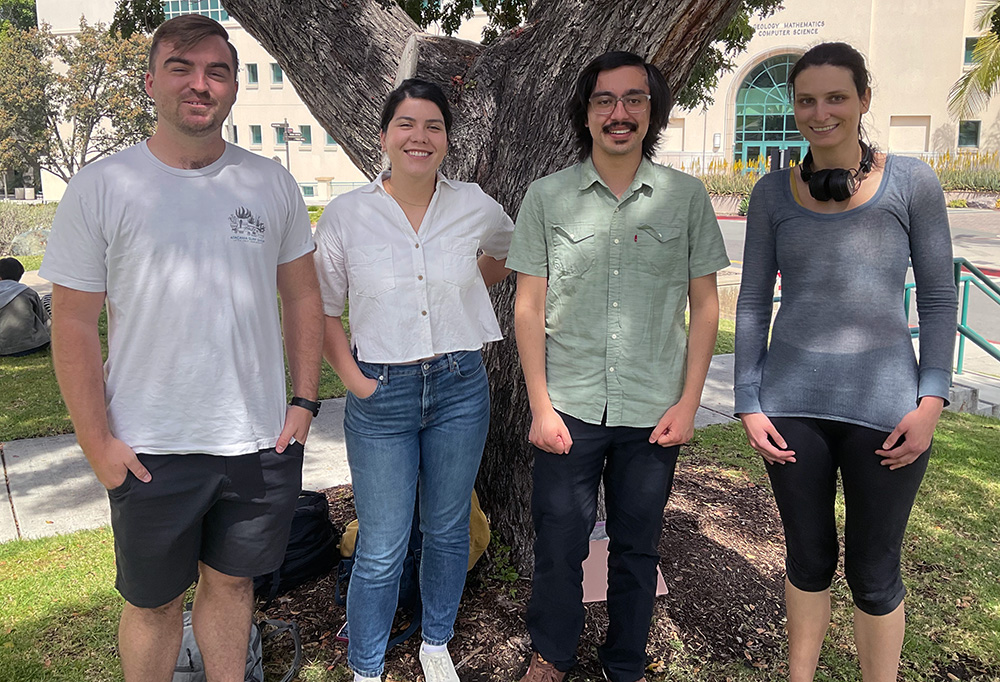
SDSU quantum physics students (from left to right): Kris McBrian, Mandy Bowman, Antonio Cobarrubia, Sasha Curcic. (Courtesy of Calvin Johnson)
Behind the film “Oppenheimer” and its star-studded cast is a science that fuels the stars.
By Bryana Quintana
One of this summer’s biggest releases, “Oppenheimer,” centers around J. Robert Oppenheimer and his team’s work on the Manhattan Project, the effort to develop the atomic bomb and help end World War II.
But nuclear physics, the scientific core of the film, is much more than what viewers will see on the screen. The science is the driving force behind an array of phenomena on Earth and in space, from making stars shine to improving medical diagnoses and treatment. Inquisitive researchers at San Diego State University study the inner workings of nuclear physics, gaining insight that contributes to the wide-ranging applications this field has to offer.
Nuclear physics is linked to quantum information science (QIS), a discipline that has grown in recent years. Just as the internet and social media have had a vast impact on modern society, quantum science offers paths to improve our understanding of the universe and completely transform the way we do things.
And, it’s already at work. Quantum cryptography enables more secure communications to help safeguard sensitive data. Quantum computers are considerably faster and more powerful than the ones used today. Scientists are even applying QIS to explore obscure facets of the cosmos.
SDSU physics professor Calvin Johnson and his students use quantum computers at national labs and supercomputing facilities to build models of atomic nuclei to better understand nuclear processes.
“Hydrogen and helium were made in the Big Bang, but everything else — the carbon in all living things, the oxygen in the air we breathe, the iron that goes into steel, the gold in our rings, the lithium in our batteries — all those elements were made from nuclear reactions in stars,” said Johnson. “So if we want to know where stuff comes from, we have to understand how those reactions occur.”
Applying the powers of quantum science to nuclear physics, Johnson and his students conduct research that can help make strides in many different fields.
Power of Stars
In addition to making stars shine, nuclear physics has a wide range of earthly applications.
Quantum computing can help scientists harness nuclear reactions to improve medicine and make nuclear reactors safer and more efficient. Nuclear medicine involves techniques like using radioactive tracers to help provide more precise diagnoses and employing a radioactive form of iodine to help target and kill tumors.
“If we want to design nuclear medicine better, if we want to be able to design our nuclear reactors better, even our most powerful computers today might not be up to the task,” Johnson said. “So part of my research is trying to see if we can use quantum computers to do better calculations of the nuclear physics that go into all these applications.”
Mandy Bowman, a computational science master’s student at SDSU with a background in mechanical engineering, works with Johnson to do just that.
“I ended up at SDSU because I was really interested in doing computational science,” Bowman said. “I really enjoyed my program and the opportunity to work with Dr. Johnson. I’m really excited to continue that journey especially within quantum computing, which is a vastly growing field right now.”
Bowman, who spent time at NASA doing computational science and has always been interested in physics, now works on developing an algorithm for quantum computers that can map the structure of an atom’s nucleus, something that cannot be done on classical computers.
Her advice to students interested in this field: “There’s tons and tons of resources online and a lot of companies are making their quantum computers available to the public. So if you’re interested, just dive into it.”
Science, Meet Cinema
As for “Oppenheimer,” Johnson said he’s looking forward to seeing it. He once conducted research at the Los Alamos National Laboratory, home of the Manhattan Project and one of the locations where the movie was filmed. Some of his students have gone on to have internships and permanent positions there, as well as at other national labs. He plans to keep a special eye out for some of his former colleagues at Los Alamos who posed as extras in the film.
Bowman is also excited about the feature.
“I was actually able to visit Los Alamos with Dr. Johnson to meet with one of our collaborators and it was really cool to experience,” she said. “It’s kind of far away from civilization, tucked up in the secret mountain. So I’m interested to see how they portray that in the movie, having been there.”
Learn more about SDSU’s Physics Department.